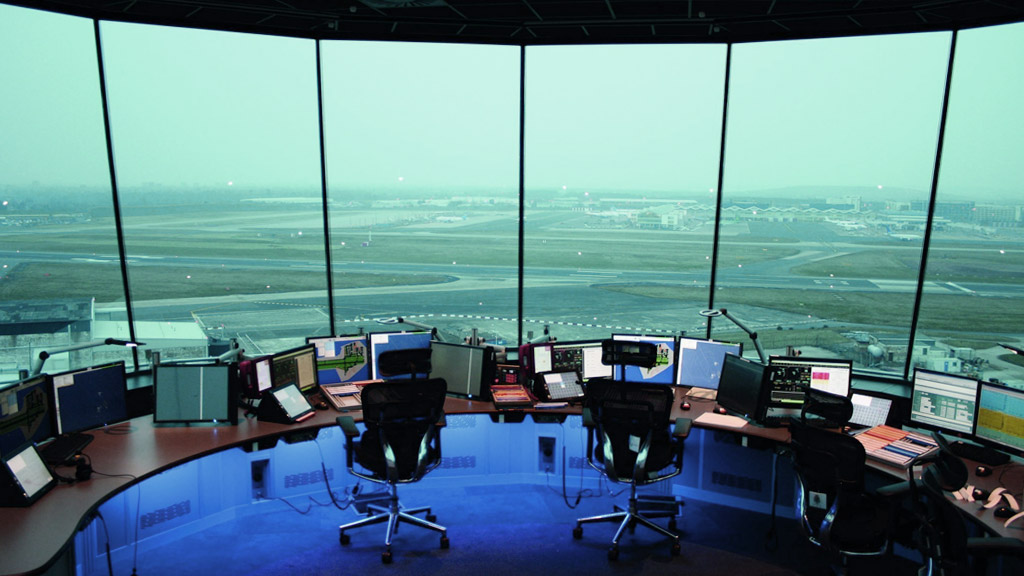This is the second installment in our multi-part look at control room furniture and design across a variety of industries. It is important to take a broad, multi-category view of control room design, not just for the sake of those within specific industries themselves; but also for designers to keep their view as wide as possible, to learn and build solutions from a variety of situations and challenges.
This article will be focusing on design elements and initiatives for clients within the Airport/Air Traffic industry. It is important for firms to be familiar with this industry, as $255 billion was invested in new airport construction in 2017 and a further $885 billion was dedicated to infrastructure upgrades—some of which was dedicated to airport control rooms.
What are some specific Airport/Air Traffic control room design features?
Perhaps more than any other category we will be considering in this series, Airport control room design is constrained by rules and regulations. Specific recommendations are beyond the scope of this paper, so we will urge designers to check with local regulators before making any concrete design decisions.
Some considerations that are common amongst many, if not all, control room furniture designs are comfortability and anti-fatigue. Airport control rooms require workers to be attentive for long stretches of time, so furniture and consoles need to be designed with ergonomic principles in mind. It isn’t hard to imagine how dangerous an uncomfortable and distracted staff member can be in this industry.
More specifically, we will consider the following areas:
- Lighting
- Acoustics
- Power
- Miscellaneous
Lighting
In many Airport industry applications, visibility of the runway is of utmost importance. As such, control room furniture designers should expect a lot of windows and therefore the potential for large amounts of natural light in the space.
Display monitors will often be attached to ceiling tracks via articulated arms to allow for easy repositioning of screens to cut down on glare (as well as to facilitate co-working).
Additionally, the use of tinted window screens is very common. These shades are often required to be within very specific ranges of color, transparency, and thickness. It is recommended to find out these requirements ahead of the design phase.
Acoustics
Construction materials within air control spaces are often necessarily highly absorbent of sound. A quiet environment ensures that operator distractions are kept to a minimum and communication between staff is unhindered. It is a good idea to find out if the client has any requirements for console materials before getting started.
For similar acoustical reasons, air traffic control room floors are likely to be carpeted. It is recommended to be aware if a client’s space does as this can impact specifications for control room furniture (i.e. chairs).
Vibration isolation for noise generating equipment could be necessary as well.
Power
It is likely the case that the amount and location of power supplies is set by specific regulations. Knowing the location and capacity of electrical outlets in the space is crucial when designing control rooms for this industry.
Air traffic control rooms will have a backup generator for cases of power failure. This may or may not impact design within the space, but it is good to be aware.
Miscellaneous
Telephones and telephone outlets are often required in certain numbers by regulation, it is important to consider these placements during initial designs.
In general, the console furniture in these types of spaces will need to be as flexible as possible to facilitate quick repositioning. The ability to make quick adjustments to accommodate multiple lines of sight is of utmost importance in emergency situations that require cooperation amongst staff.
A certain amount of clearance between consoles may be required for the easy movement of personnel and equipment.
In at least some cases, raised flooring will be used. It is vital to check the weight limits of the materials used and consider these when choosing consoles and furniture.
As we’ve seen here, control room design for Airport/Air Traffic industry is subject to various rules and regulations from both governmental and organizational entities. Anything from the color of the blinds to the amount of electrical outlets may fall under very specific guidelines that control room design firms need to be in compliance with.
We’ve given a brief overview here, but this is far from exhaustive. There is no shortcut to design in these high stakes environments. As such, we recommend working closely with clients and regulators to develop workable designs.
Make sure to check back as we examine other industry categories that make use of control room consoles, so that you can be prepared for any potential client. And when you need superior yet affordable products for your data center, contact our support staff at Inracks anytime.








